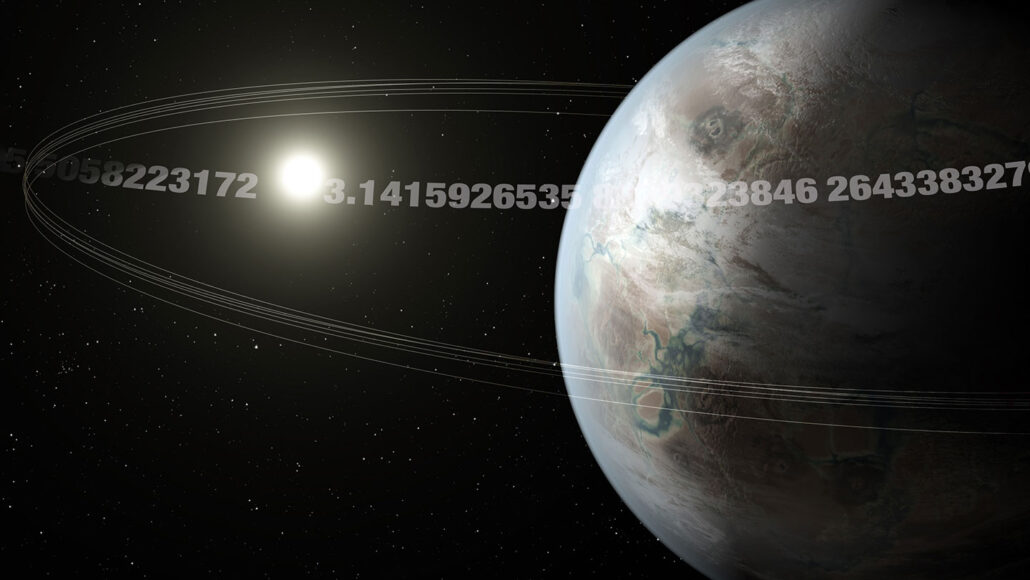Meet ‘Pi’ — a new Earth-sized planet
The exoplanet's nickname refers to its 3.14-day orbit and is a pun for its warm surface temperature

Scientists discovered a planet called K2-315b. They nicknamed it “Pi Earth” because it orbits its star every 3.14 days.
NASA Ames/JPL-Caltech/T. Pyle, Christine Daniloff, MIT
Researchers have discovered a new Earth-sized planet. It’s orbiting a dim red star some 185 light-years away. The planet’s official name is K2-315b. But its nickname is “Pi Earth.” The reason: It orbits its star every 3.14 days.
That orbit reminded astronomers of the irrational number pi, written as the Greek letter π. An irrational number is one that can’t be written as a fraction or a ratio. And the first three digits of pi are 3.14.
Pi is also a mathematical constant. To calculate it, you need to know just two measurements from any circle. The first one is the circle’s circumference. And the second one is the circle’s diameter. To find pi, just divide that circle’s circumference by its diameter. This number will be the same no matter what circle you started with. There are an infinite number of digits in the pi.
Astronomers don’t know exactly how warm K2-315b is. That’s because they don’t know much about its atmosphere or inner workings. Instead, scientists have to imagine how warm the planet would be if it were a simple dark ball heated only by its star. In that case, its surface temperature would be about a toasty 187º Celsius (368º Fahrenheit). That’s warm enough to boil water or cook tasty desserts, such as pie, notes Prajwal Niraula.
It also suggests this planet is likely too warm to be habitable, he adds. Niraula is a planetary scientist who studies exoplanets. He works at the Massachusetts Institute of Technology in Cambridge. He was part of a team that described this new exoplanet September 21 in The Astronomical Journal.
The researchers discovered the new planet while looking through data from NASA’s K2 Mission, which ended in October 2018. Explains Niraula, that’s “when the spacecraft ran out of fuel.” Once the researchers realized they had found an interesting object to study, they needed to confirm it was a planet. To do that, they used a network of ground-based telescopes and historical images of the sky.

Educators and Parents, Sign Up for The Cheat Sheet
Weekly updates to help you use Science News Explores in the learning environment
Thank you for signing up!
There was a problem signing you up.
Cool discovery from a cool star
“This study presents a new, fairly temperate, [rocky] planet around a low-mass, cool star,” says Johanna Teske. She was not involved with the new study. But this astronomer knows what to make of such findings. She studies exoplanets at the Carnegie Institution for Science in Washington, D.C.
Even a “cool star” is hot to you and me. The surface of Pi Earth’s star is about 3,000 ºC (5,500 ºF). Astronomers call it cool because most stars are much hotter. Our sun, for example, is about 5,500º Celsius (10,000º Fahrenheit).
Pi Earth was detected “as part of a survey specifically for planets around these very cool stars,” Teske says. “This type of survey is exciting,” she says, “because it is really focused on finding the smallest planets.” To scout for them, she says, researchers “are looking around the smallest stars.” And she finds the data on Pi Earth “the most promising signal from the survey so far.”
“Smaller planets are easier to detect around smaller stars,” she points out, “because they block out a higher fraction of the star’s light.” That’s how many exoplanets are found. When a planet passes between its star and Earth, the star’s light dims. If Pi Earth’s home star was as big as our sun, Teske notes, astronomers might never have detected it.
Astronomers couldn’t measure how big Pi Earth is directly, Niraula notes. So they measured how big a shadow it cast as it made several passes, or transits, in front of its star. His team fed those measurements into a computer model to calculate the planet’s size relative to its star.
“Planets around cool stars are, right now, one of the best bets for finding ‘temperate’ planets,” Teske says. Those planets are also described as existing in a Goldilocks zone. That means they “are cool enough to have liquid water on the surface,” she notes. Many of the planets detected in seemingly habitable zones “are around small stars,” she says.
Looking ahead, Niraula wants to study the atmosphere blanketing Pi Earth. He says his team is “excited” to study the chemical recipe of this atmosphere. He describes an atmosphere as “a gateway” to better understanding the makeup of the planet itself. With such information, he says, “You can make a lot of inferences, such as, like, ‘Is there life there?’”
“Almost all planet-detection papers are the work of a large team,” Teske says. “This paper is no exception.” Even in the subfield of exoplanets, she notes, lots of people share their unique expertise and efforts to finding and understanding these distant worlds. And, she notes, “There are lots of ways to get involved in planet detection, including through citizen-science projects like Planet Hunters. Maybe you will also help find a new planet!”







